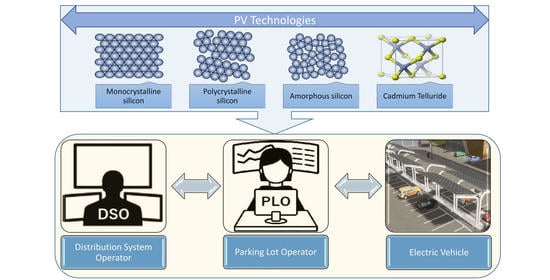Optimal Operation of Solar Powered Electric Vehicle Parking Lots Considering Different Photovoltaic Technologies
Abstract
:1. Introduction
1.1. Literature Review
1.2. Contributions
2. Problem Formulation
2.1. Objective Function
2.2. Constraints
2.3. Equations for PV Generation
3. Case Study
4. Results and Discussion
4.1. PLO’s Profit without PV Generation
4.2. PLO’s Profit with PV Generation
5. Conclusions
Author Contributions
Funding
Institutional Review Board Statement
Informed Consent Statement
Data Availability Statement
Acknowledgments
Conflicts of Interest
Nomenclature
| Indices | |
| n | Index for EV number |
| w | Index for scenarios |
| h | Index for time (hour) |
| Parameters | |
| Ccd | Cost of equipment depreciation (€/kWh) |
| Rmax | Maximum charging/discharging rate (kWh) |
| SOEarv | Initial SOE of EVs at the arrival time to PL (kWh) |
| SOEdep | Desired SOE of EVs at the departure time from PL (kWh) |
| SOEmax | Maximum rate of SOE (kWh) |
| SOEmin | Minimum rate of SOE (kWh) |
| tarv | Arrival time of EVs to the PL |
| tdep | Departure time of Evs |
| Prch | Charging tariff of EVs (€/kWh) |
| PrGrid | Price of purchasing energy from DSO by PL (€/kWh) |
| Prdch | Price of selling energy to DSO by PL (€/kWh) |
| ηch | Charging efficiency (%) |
| ηdch | Discharging efficiency (%) |
| probability of each scenario | |
| Variables | |
| Pch-Grid | Charging power of each EV from DSO (kW) |
| Pch-Solar | Charging power of each EV from solar energy’s output (kW) |
| Pdch-Grid | Discharging power of PL to DSO (kW) |
| PSolar | Solar energy’s output of PL to DSO (kW) |
| SOE | EVs’ state of energy (kWh) |
| Xch | Binary variable which shows the charge status of each EV |
References
- Adeeb, J.; Farhan, A.; Al-Salaymeh, A. Temperature Effect on Performance of Different Solar Cell Technologies. J. Ecol. Eng. 2019, 20, 249–254. [Google Scholar] [CrossRef]
- Amelia, A.R.; Irwan, Y.M.; Leow, W.Z.; Irwanto, M.; Safwati, I.; Zhafarina, M. Investigation of the Effect Temperature on Photovoltaic (PV) Panel Output Performance. Int. J. Adv. Sci. Eng. Inf. Technol. 2016, 6, 5. [Google Scholar]
- Kawajiri, K. Effect of Temperature on PV Potential in the World. Environ. Sci. Technol. 2011, 45, 9030–9035. [Google Scholar] [CrossRef] [PubMed]
- Kamkird, K.; Ketjoy, N.; Rakwichian, W.; Sukchai, S. Investigation on Temperature Coefficients of Three Types Photovoltaic Module Technologies under Thailand Operating Condition. Procedia Eng. 2012, 32, 376–383. [Google Scholar] [CrossRef] [Green Version]
- Global EV Report. Available online: https://www.iea.org/reports/global-ev-outlook-2019 (accessed on 20 January 2021).
- Chukwu, U.C.; Mahajan, S.M. V2G parking lot with PV rooftop for capacity enhancement of a distribution system. IEEE Trans. Sustain. Energy 2013, 5, 119–127. [Google Scholar] [CrossRef]
- Honarmand, M.; Zakariazadeh, A.; Jadid, S. Self-scheduling of electric vehicles in an intelligent parking lot using stochastic optimization. J. Frankl. Inst. 2015, 352, 449–467. [Google Scholar] [CrossRef]
- Heydarian-Forushani, E.; Golshan, M.E.; Shafie-khah, M. Flexible interaction of plug-in electric vehicle parking lots for efficient wind integration. Appl. Energy 2016, 179, 338–349. [Google Scholar] [CrossRef]
- Song, Y.; Zheng, Y.; Hill, D.J. Optimal scheduling for EV charging stations in distribution networks: A Convexified model. IEEE Trans. Power Syst. 2016, 32, 1574–1575. [Google Scholar] [CrossRef]
- Ivanova, A.; Fernandez, J.A.; Crawford, C.; Djilali, N. Coordinated charging of electric vehicles connected to a net-metered PV parking lot. In Proceedings of the 2017 IEEE PES Innovative Smart Grid Technologies Conference Europe (ISGT-Europe), Turin, Italy, 26–29 September 2017; pp. 1–6. [Google Scholar]
- Figueiredo, R.; Nunes, P.; Brito, M.C. The feasibility of solar parking lots for electric vehicles. Energy 2017, 140, 1182–1197. [Google Scholar] [CrossRef]
- Aghajani, S.; Kalantar, M. Operational scheduling of electric vehicles parking lot integrated with renewable generation based on bi-level programming approach. Energy 2017, 139, 422–432. [Google Scholar] [CrossRef]
- Zhang, Y.; Cai, L. Dynamic charging scheduling for EV parking lots with photovoltaic power system. IEEE Access 2018, 6, 56995–57005. [Google Scholar] [CrossRef]
- Yan, Q.; Zhang, B.; Kezunovic, M. Optimized operational cost reduction for an EV charging station integrated with battery energy storage and PV generation. IEEE Trans. Smart Grid 2018, 10, 2096–2106. [Google Scholar] [CrossRef]
- Eldeeb, H.H.; Faddel, S.; Mohammed, O.A. Multi-objective optimization technique for the operation of grid tied PV powered EV charging station. Electr. Power Syst. Res. 2018, 164, 201–211. [Google Scholar] [CrossRef]
- Jannati, J.; Nazarpour, D. Multi-objective scheduling of electric vehicles intelligent parking lot in the presence of hydrogen storage system under peak load management. Energy 2018, 163, 338–350. [Google Scholar] [CrossRef]
- Chen, C.R.; Chen, Y.S.; Lin, T.C. Optimal Charging Scheduling for Electric Vehicle in Parking Lot with Renewable Energy System. In Proceedings of the 2019 IEEE International Conference on Systems, Man and Cybernetics (SMC), Bari, Italy, 6–9 October 2019; pp. 1684–1688. [Google Scholar]
- Jiang, W.; Zhen, Y. A Real-time EV Charging Scheduling for Parking Lots with PV System and Energy Store System. IEEE Access 2019, 7, 86184–86193. [Google Scholar] [CrossRef]
- Turan, M.T.; Ates, Y.; Erdinc, O.; Gokalp, E.; Catalão, J.P. Effect of electric vehicle parking lots equipped with roof mounted photovoltaic panels on the distribution network. Int. J. Electr. Power Energy Syst. 2019, 109, 283–289. [Google Scholar] [CrossRef]
- Seddig, K.; Jochem, P.; Fichtner, W. Two-stage stochastic optimization for cost-minimal charging of electric vehicles at public charging stations with photovoltaics. Appl. Energy 2019, 242, 769–781. [Google Scholar] [CrossRef]
- Sedighizadeh, M.; Mohammadpour, A.; Alavi, S.M.M. A daytime optimal stochastic energy management for EV commercial parking lots by using approximate dynamic programming and hybrid big bang big crunch algorithm. Sustain. Cities Soc. 2019, 45, 486–498. [Google Scholar] [CrossRef]
- Ahmadi-Nezamabad, H.; Zand, M.; Alizadeh, A.; Vosoogh, M.; Nojavan, S. Multi-objective optimization based robust scheduling of electric vehicles aggregator. Sustain. Cities Soc. 2019, 47, 101494. [Google Scholar] [CrossRef]
- Wang, Z.; Jochem, P.; Fichtner, W. A scenario-based stochastic optimization model for charging scheduling of electric vehicles under uncertainties of vehicle availability and charging demand. J. Clean. Prod. 2020, 254, 119886. [Google Scholar] [CrossRef]
- Cao, Y.; Du, J.; Qian, X.; Nojavan, S.; Jermsittiparsert, K. Risk-involved stochastic performance of hydrogen storage based intelligent parking lots of electric vehicles using downside risk constraints method. Int. J. Hydrog. Energy 2020, 45, 2094–2104. [Google Scholar] [CrossRef]
- Cao, Y.; Huang, L.; Li, Y.; Jermsittiparsert, K.; Ahmadi-Nezamabad, H.; Nojavan, S. Optimal scheduling of electric vehicles aggregator under market price uncertainty using robust optimization technique. Int. J. Electr. Power Energy Syst. 2020, 117, 105628. [Google Scholar] [CrossRef]
- Bayrakcia, M.; Choib, Y.; Brownson, J. Temperature Dependent Power Modeling of Photovoltaics. Energy Procedia 2014, 57, 745–754. [Google Scholar] [CrossRef] [Green Version]
- Dash, P.K.; Gupta, N.C. Effect of Temperature on Power Output from Different Commercially available Photovoltaic Modules. Int. J. Eng. Res. Appl. 2015, 5, 148–151. [Google Scholar]
- Zhu, H.; Lian, W.; Lu, L.; Kamunyu, P.; Yu, C.; Dai, S.; Hu, Y. Online Modelling and Calculation for Operating Temperature of Silicon-Based PV Modules Based on BP-ANN. Int. J. Photoenergy 2017, 2017, 6759295. [Google Scholar] [CrossRef] [Green Version]
- Fesharaki, V.J.; Dehghani, M.; Fesharaki, J.J. The Effect of Temperature on Photovoltaic Cell Efficiency. In Proceedings of the 1st International Conference on Emerging Trends in Energy Conservation—ETEC, Tehran, Iran, 30–21 November 2011. [Google Scholar]
- Finnish Weather Data. Available online: https://www.ilmatieteenlaitos.fi/havaintojen-lataus (accessed on 20 January 2021).
- Sadati, S.M.B.; Moshtagh, J.; Shafie-Khah, M.; Rastgou, A.; Catalão, J.P. Optimal charge scheduling of electric vehicles in solar energy integrated power systems considering the uncertainties. In Electric Vehicles in Energy Systems; Springer: Cham, Switzerland, 2020; pp. 73–128. [Google Scholar]
- Prices for Electricity Products. Available online: https://www.vaasansahko.fi/en/prices-for-electricity-products-2/ (accessed on 15 December 2020).
- Nordpool Market Data. Available online: https://www.nordpoolgroup.com/ (accessed on 15 December 2020).
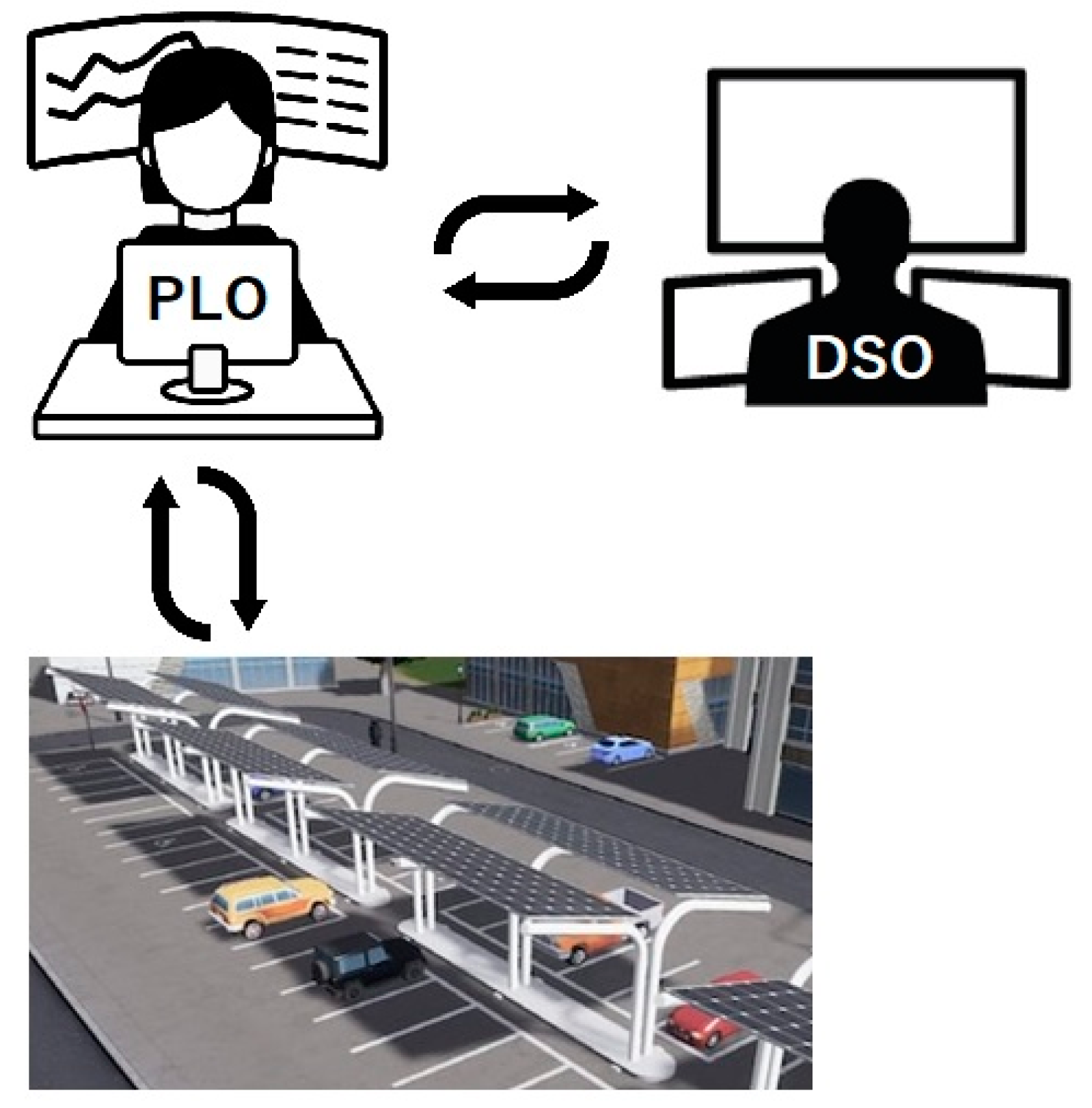
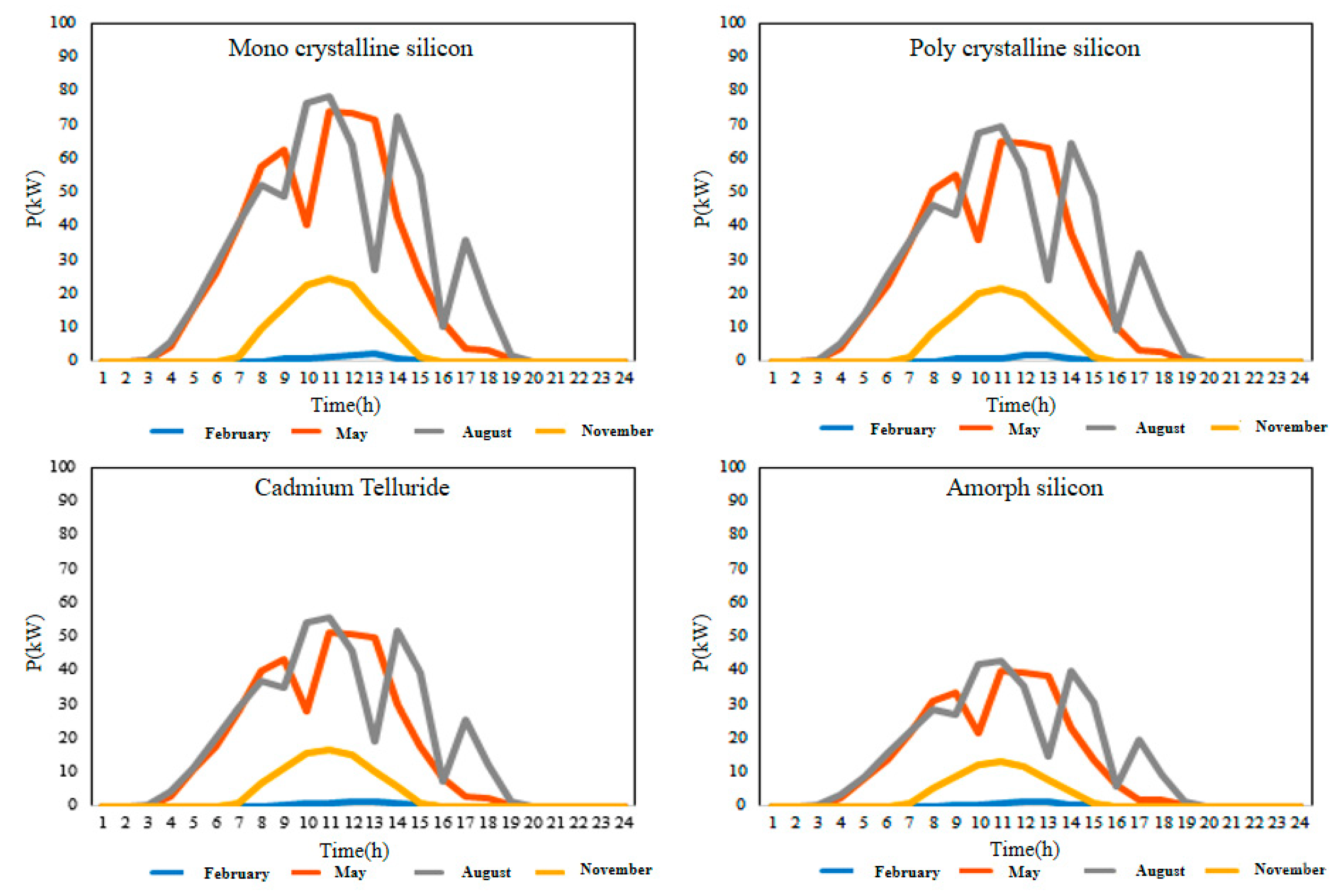
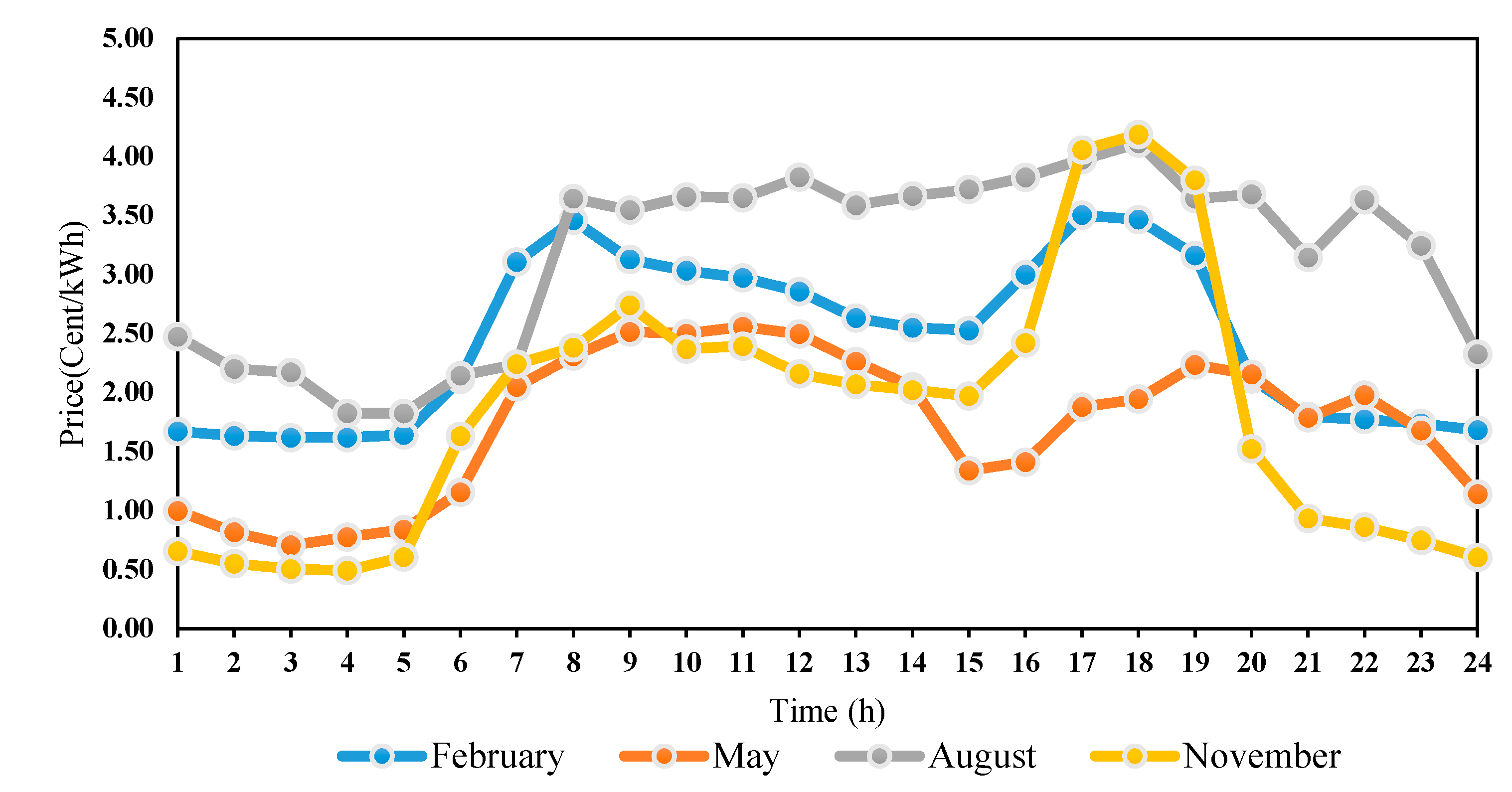
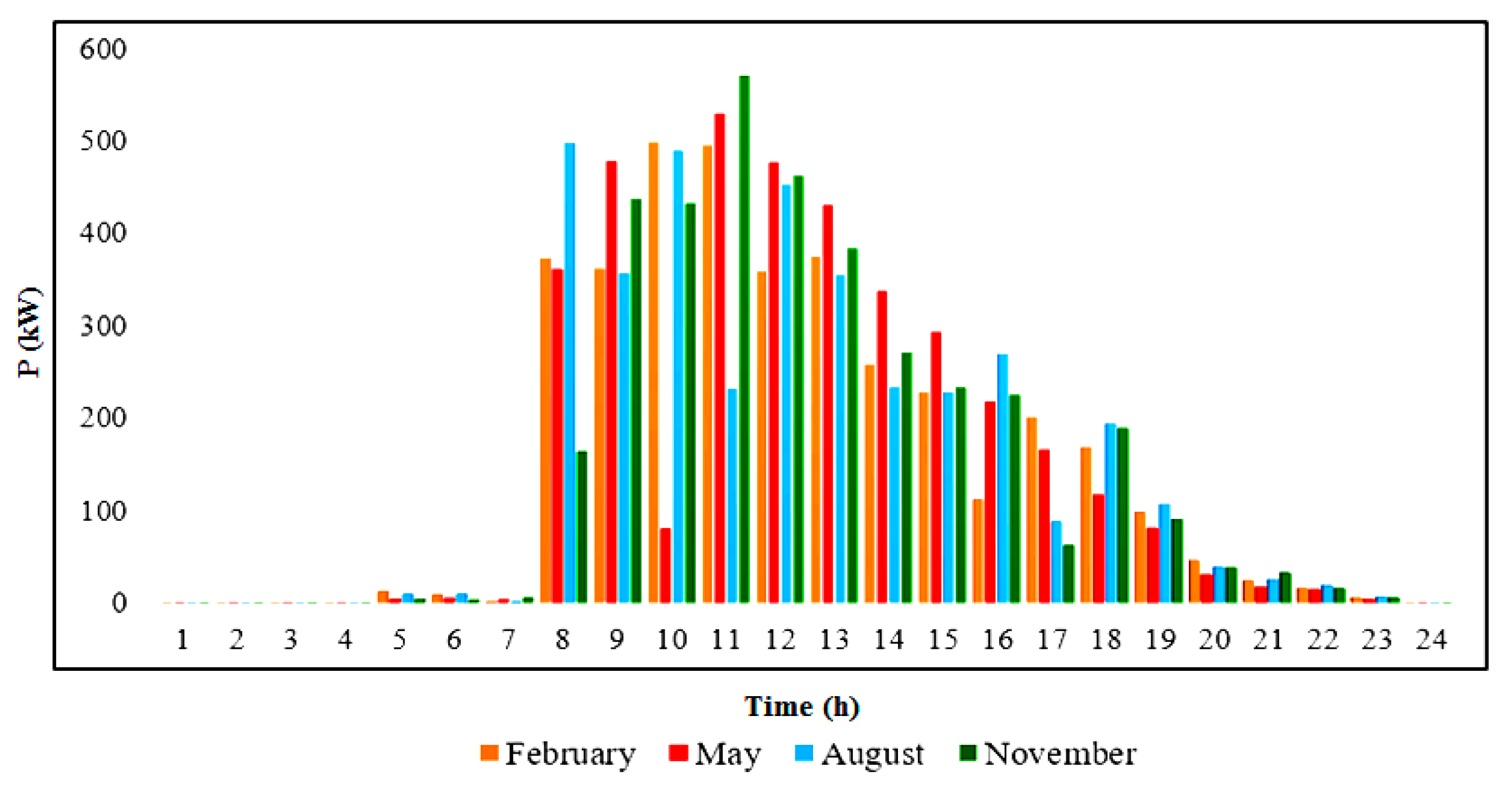
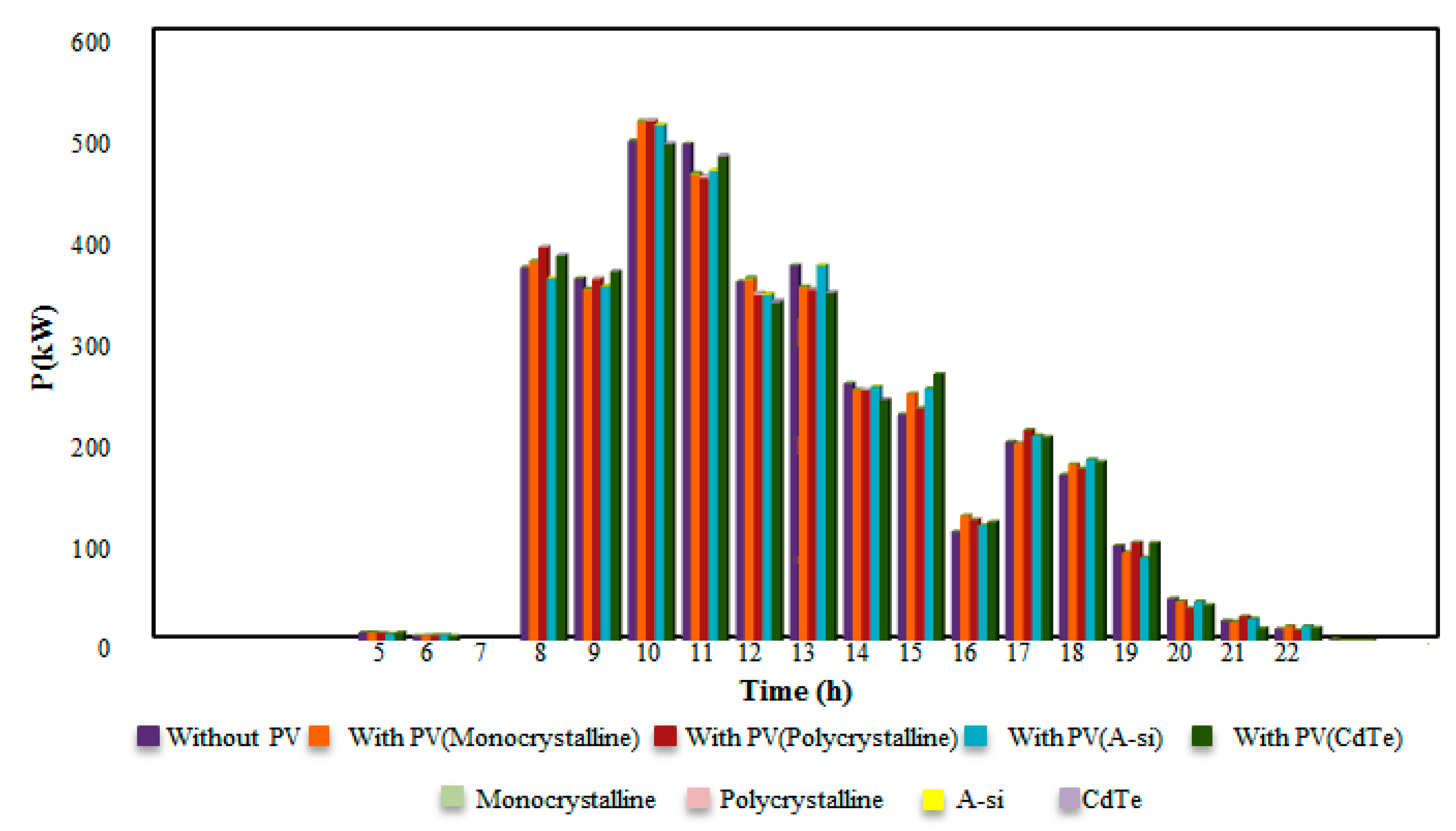
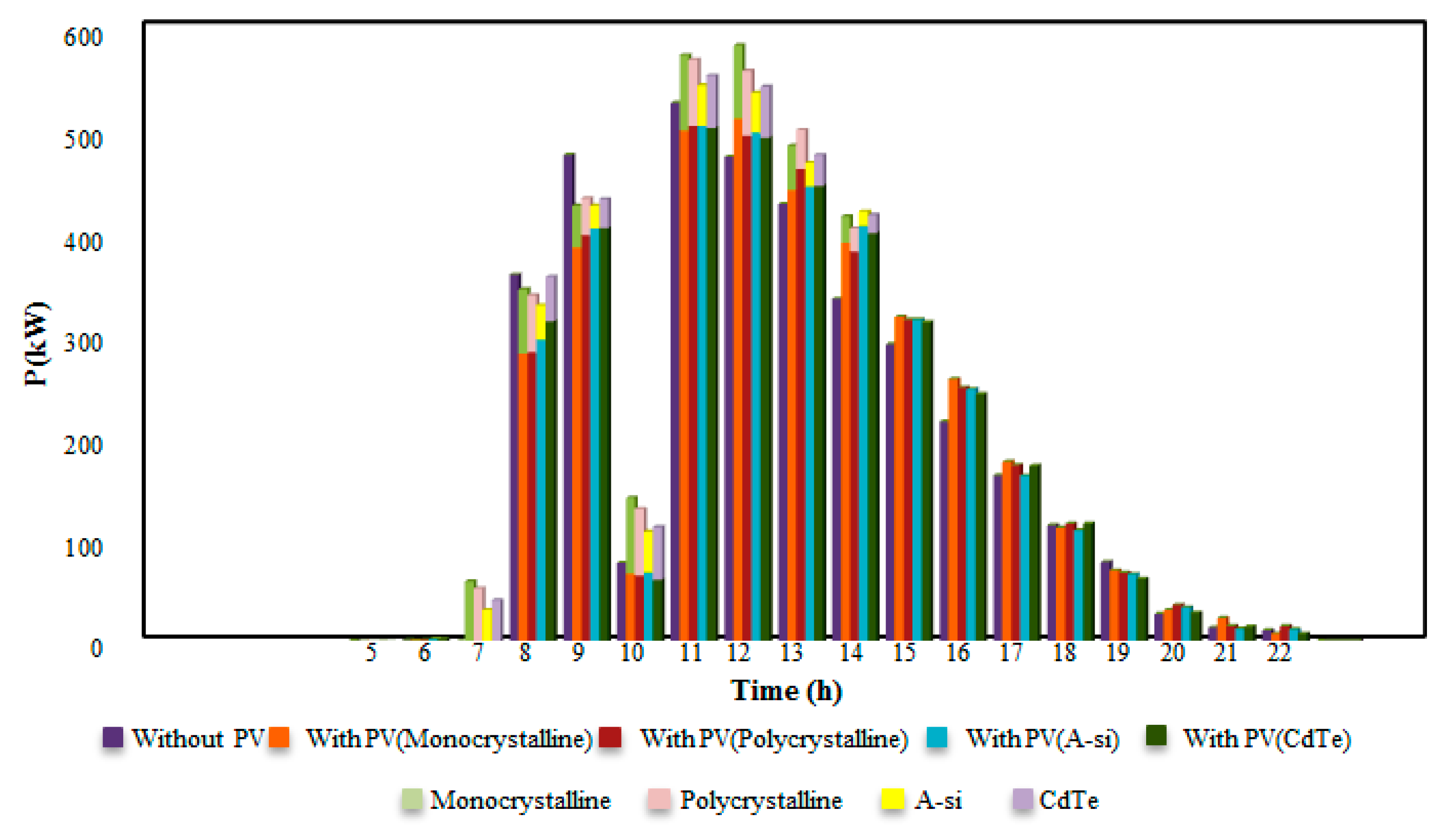
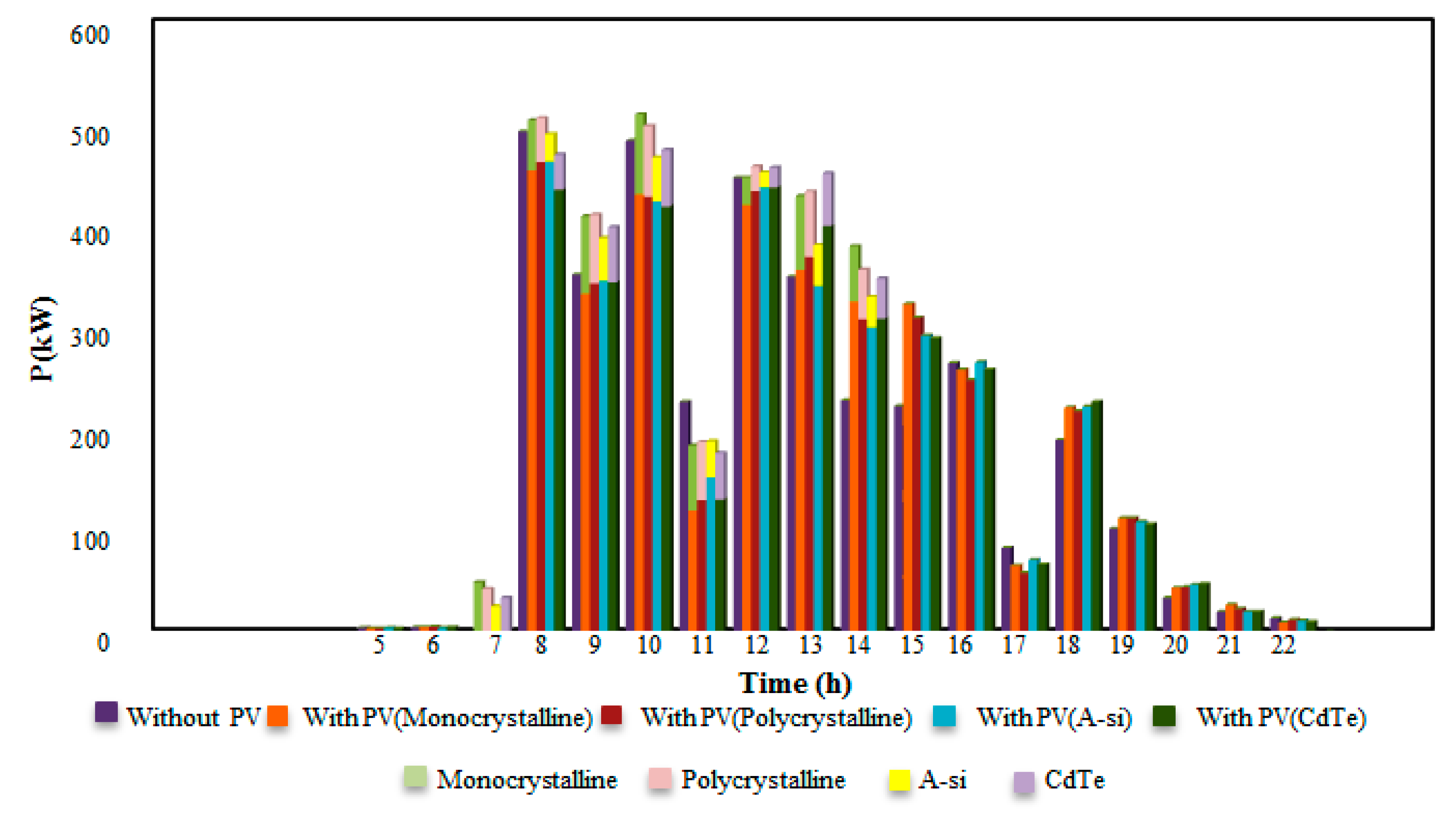
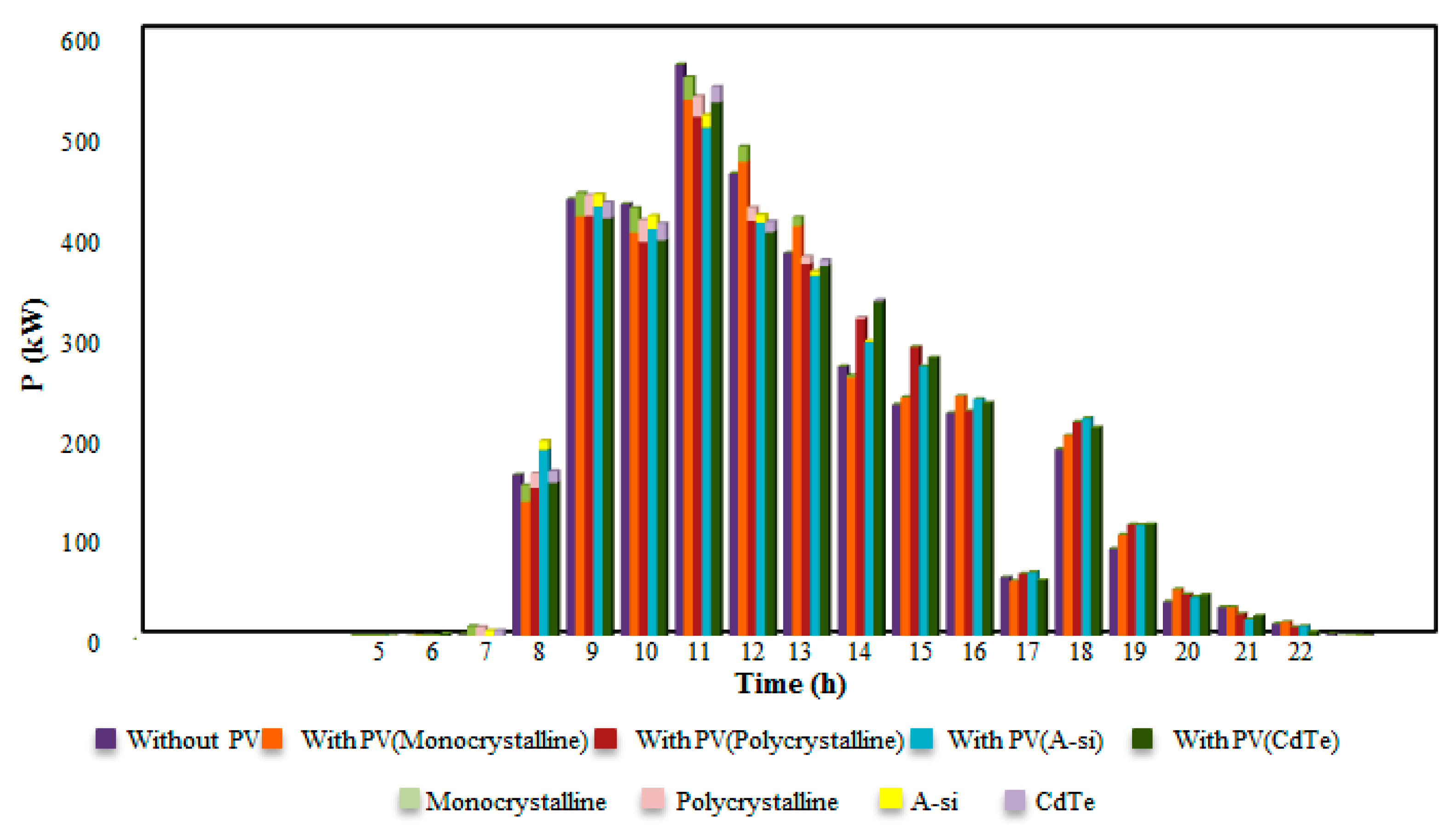
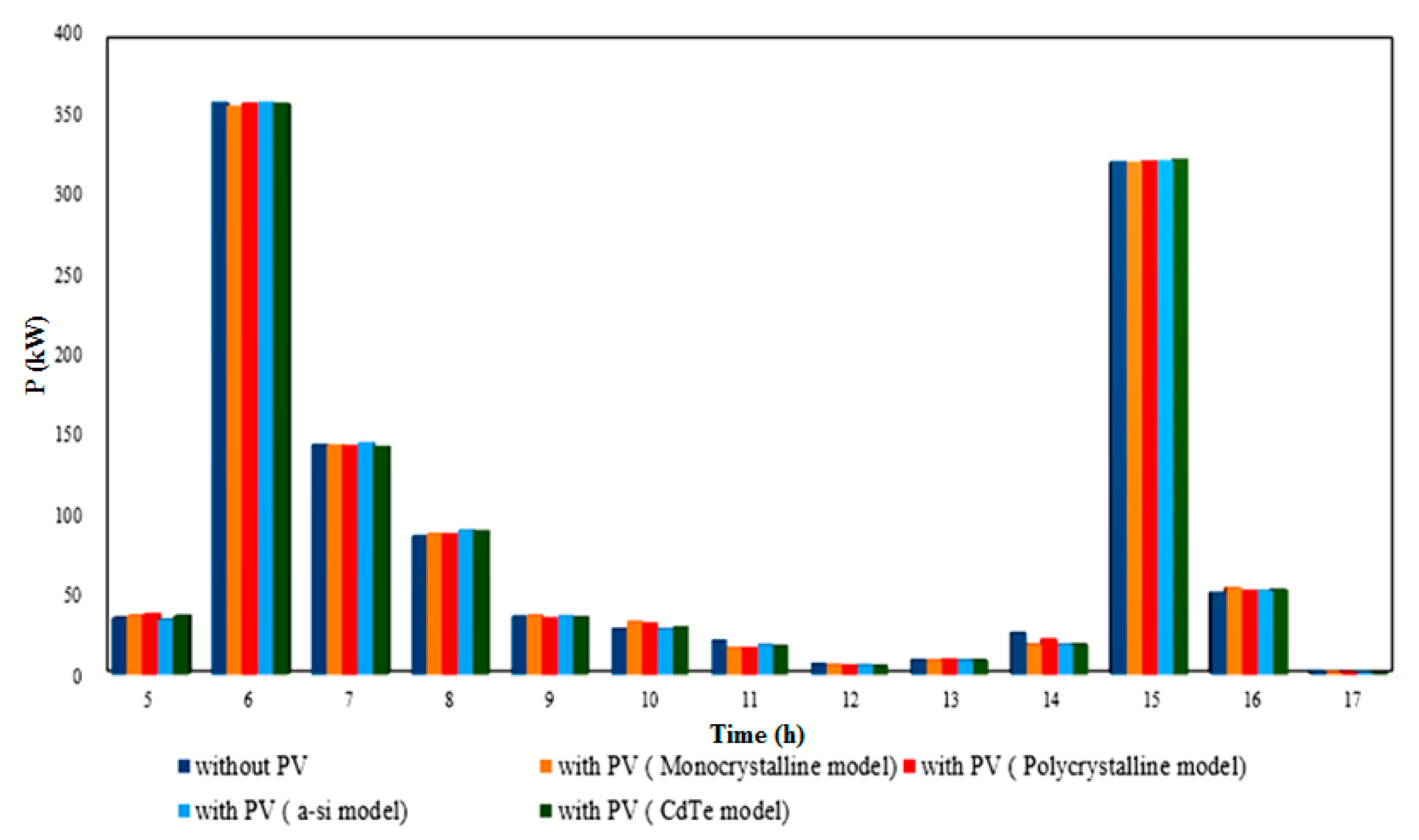
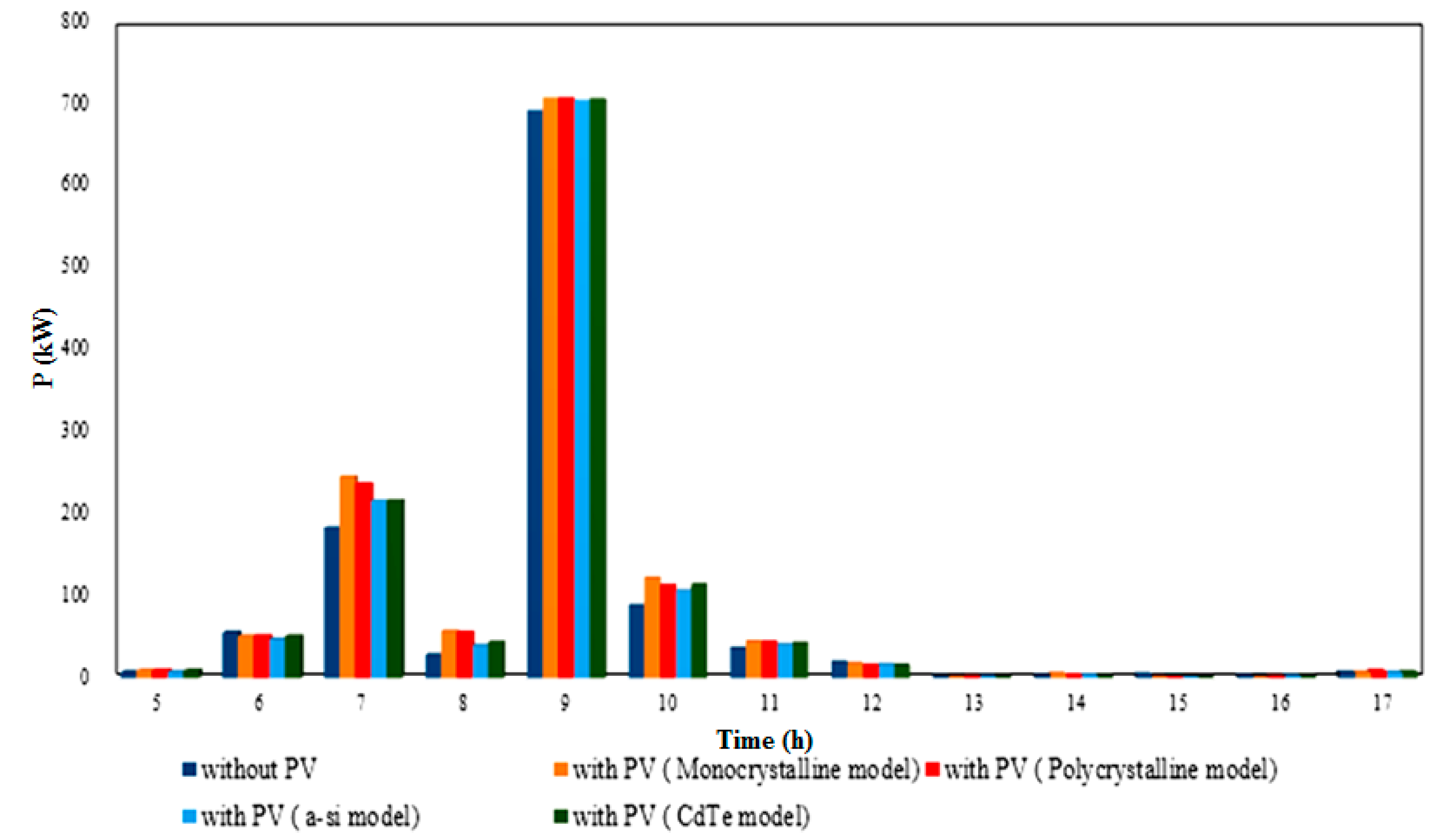


| Cell Type | Structure | Efficiency [1,2,3] | Thermal Coefficient (C−1) |
|---|---|---|---|
| Monocrystalline silicon |
| 17–22% | 0.0044 |
| Polycrystalline silicon |
| 15–17% | 0.0038 |
| Thin film solar panels: Amorphous silicon Cadmium Telluride |
| 10–13% | 0.0023 0.0017 |
| Mean | Standard Deviation | Minimum | Maximum | |
|---|---|---|---|---|
| Initial SOC (%) | 54.85 | 8.92 | 40 | 70 |
| The time of Arrival (h) | 8 | 3 | 5 | 23 |
| The time of Departure (h) | 16 | 3 | 6 | 24 |
| Cap (kW) | 62.79 | 28.60 | 18 | 95 |
| Capacity of Battery | 32 kWh | Efficiency of Charge | 90% |
| The rate of Charging/discharging | 10 kW | Efficiency of Discharge | 95% |
| SOE min | 4.8 kWh | Desired SOE | 28.8 kWh |
| SOE max | 28.8 kWh | Ccd | 20 €/MWh |
| Price/Time | Off-Peak Periods (01:00–06:00) | Mid-Peak Periods (07:00–11:00, 18:00–19:00) | On-Peak Periods (12:00–17:00) |
|---|---|---|---|
| Energy purchased from DSO by the PLOs | 4.19 | 4.19 | 4.19 |
| Energy sold to EVO by the PLO | 4.67 | 5.53 | 5.53 |
| Month | February | May | August | November |
|---|---|---|---|---|
| Charging (kWh) | 3636.94 | 3636.94 | 3608.85 | 3620.89 |
| Discharging (kWh) | 1123.22 | 1128.01 | 1311.24 | 1285.6 |
| PLO’s profit (€) | 44.70 | 40.25 | 47.33 | 42.65 |
| February | May | August | November | |||||
|---|---|---|---|---|---|---|---|---|
| Pch from DSO | Pch to DSO | Pch from DSO | Pch to DSO | Pch from DSO | Pch to DSO | Pch from DSO | Pch to DSO | |
| Without PV | 3636.94 | 1123.22 | 3636.94 | 1128.01 | 3608.85 | 1311.24 | 3620.89 | 1285.60 |
| Mono crystalline | 3628.06 | 1118.80 | 3625.13 | 1267.40 | 3598.09 | 1340.39 | 3600.57 | 1283.05 |
| Poly crystalline | 3628.13 | 1118.44 | 3627.21 | 1246.91 | 3598.1 | 1313.35 | 3600.52 | 1279.27 |
| Amorphous silicon | 3628.84 | 1117.95 | 3632.94 | 1192.80 | 3598.9 | 1239.24 | 3602.47 | 1277 |
| Cadmium Telluride | 3628.44 | 1118.09 | 3627.70 | 1212.60 | 3595.93 | 1272.83 | 3602.98 | 1281.32 |
| PV Technology/Month | February | May | August | November |
|---|---|---|---|---|
| Without PV | 44.70 | 40.25 | 47.33 | 42.65 |
| Mono crystalline | 45.06 | 63.26 | 72.73 | 48.85 |
| Poly crystalline | 45.01 | 60.52 | 69.82 | 48.11 |
| Amorphous silicon | 44.87 | 52.72 | 61.25 | 45.89 |
| Cadmium Telluride | 44.93 | 56.26 | 65.36 | 46.86 |
Publisher’s Note: MDPI stays neutral with regard to jurisdictional claims in published maps and institutional affiliations. |
© 2021 by the authors. Licensee MDPI, Basel, Switzerland. This article is an open access article distributed under the terms and conditions of the Creative Commons Attribution (CC BY) license (https://creativecommons.org/licenses/by/4.0/).
Share and Cite
Farahmand, M.Z.; Javadi, S.; Sadati, S.M.B.; Laaksonen, H.; Shafie-khah, M. Optimal Operation of Solar Powered Electric Vehicle Parking Lots Considering Different Photovoltaic Technologies. Clean Technol. 2021, 3, 503-518. https://doi.org/10.3390/cleantechnol3020030
Farahmand MZ, Javadi S, Sadati SMB, Laaksonen H, Shafie-khah M. Optimal Operation of Solar Powered Electric Vehicle Parking Lots Considering Different Photovoltaic Technologies. Clean Technologies. 2021; 3(2):503-518. https://doi.org/10.3390/cleantechnol3020030
Chicago/Turabian StyleFarahmand, Mahsa Z., Sara Javadi, Sayyed Muhammad Bagher Sadati, Hannu Laaksonen, and Miadreza Shafie-khah. 2021. "Optimal Operation of Solar Powered Electric Vehicle Parking Lots Considering Different Photovoltaic Technologies" Clean Technologies 3, no. 2: 503-518. https://doi.org/10.3390/cleantechnol3020030






